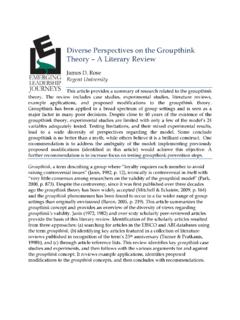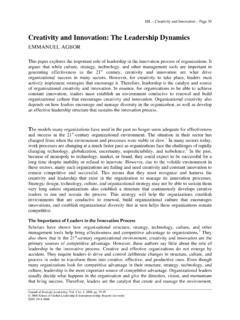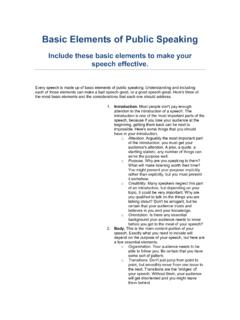Transcription of Speaking to Persuade - regent.edu
1 Speaking to PersuadeCenter for Student Development regent University11 Center for Student DevelopmentRegent UniversitySpeakingtoPersuade2We re going Review elements of persuasion Design speeches Give speeches3 Types of Persuasion Convince * Inspire Motivate4 Elements of Persuasion Who are you? Who is the audience? Tactics to facilitatecredibility5 Who are you? Audience must like you,trust you, respect you, and identify with you. How?6 Knowledge Qualified to discuss subject Offer evidence to supportyour to PersuadeCenter for Student Development regent University27 Reputation Communicate your qualifications (humbly)through advance publicity,your introduction, yourspeech content. Self-deprecation can Speak with conviction. Make it clear you haveaudience interests in mind. 9 Delivery Speak firmly and confidently. Use direct eye contact. Respect opponents views. Agree/concede minor is the audience?
2 Friendly reinforce theirposition Apathetic convince themthat the issue affects them, present arguments 11 Who is the audience? Hostile respect them,present new information tothem before asking them tochange their position(protect ego), present meritsof your position 12 Who is the audience? Uninformed educate, convince them of importanceof the issue, presentarguments MixedSpeaking to PersuadeCenter for Student Development regent University313 Tactics to facilitatecredibility Hear where they re comingfrom Provide the proof they needto change their position14 Tactics .. Arouse their interest Help them assimilate new information Avoid hyperbole Stress common ground15 Tactics ..Use logic. Present evidence that isclear, reliable, andunambiguous in meaning. Address conflicting evidence,weakest point last. Use your strongest point ..Use emotion. Arouse happiness, sadness,fear, anger, guilt, What s in it for them?17 Tactics.
3 Organization. Problem/Solution/Benefits Proposition/Proof (May further alienate hostile listeners.) Problem/Menu ofsolutions/Relative benefits(and why yours is best)18 Design a Speech Choose an audience. Choose a topic. Choose an organizational : Toastmasters Communication and Leadership Program Manual1 Professional public SpeakingProfessional public SpeakingPersuasion: Changing Hearts, Changing Minds Why speak?I Peter 4:11 NLT (the Book) --Are you called to be a speaker ? Then speak as though God himself were Speaking through you. Are you called to help others? Do it with all the strength and energy that God supplies. Then God will be given glory in everything through Jesus MottoChristian Leadership to Change the World."Give me 26 lead soldiers "Give me 26 lead soldiers and I will conquer the and I will conquer the ----Benjamin FranklinBenjamin Franklinand Karl Marxand Karl MarxYou are the message -- be yourself, at your best, with God's is Your CEO?Always begin with prayer -- great communication comes from being in communication with is Your Purpose?
4 The Four General Purposes of Communication:To informTo persuadeTo entertainTo inspireWhat is your purpose? What are you afraid of?Overcoming the Fear I would rather die, than speak in public . Most surveys rank fear of public Speaking ahead of fear of death and fear of snakes. I d rather be the corpse in the coffin, than the person giving the eulogy at the funeral. You can overcome by being Fear: Be PreparedDo your homework -- 6th grade best communicators = the best researchers. Meet the challenge:Success = Preparation meeting OpportunityKnow Your Audience You need to do some background research and get an idea of who the audience is, their political tone, agendas, and what issues are important to -- Les Stein, president, Stein & Co. CommunicationsUnderstand Audience MemoryUnderstand Audience MemoryTimeAmount of SpeechRemembered++-Understanding What You re Up Against 2000 Allyn & BaconMessageMessage&&ChannelChannelRecei vers/DecodersNoiseContextFeedbackFeedbac kFrame ofReferenceFeedforwardFeedforwardFrames ofReferenceSender/EncoderPresentation ConstructionOutlines for clarityOutlines for memorySpeech construction takes time Prepare for the worst -- always have a backup your work -- and then work your Construction: The TemplateRonald Reagan: Tell them what you re gonna tell tell them what you ve told them.
5 3 The Template: The Introduction Tell them what you re going to tell them. Hook -- the first seven seconds are crucialState the thesisPreview of main pointsGive them a reason to listenEstablish credibilityTypes of Introductions:Anecdotal StoryRhetorical QuestionQuotationHumorStatement of PurposeStatement of importance of topicSurprising statistic or claimIdentification with audienceReference to a particular news eventThe Template: The Body Tell them. Transition from Introduction to the first main point -- and then from point to point can have a = purposeI = informationE = exampleR = referenceThe Template: The Conclusion Tell them what you ve told them. Transition from Body into the the main moral of the ASK! Especially important in a persuasive of Conclusions:Anecdote or case studyRefer to your introduction -- frame the speechPersonal referenceChallenge to the audienceVision of the futureQuotationRhetorical questionHumor Logic Moves People ..you should never try to make them cry.
6 You should try to make them, or help them, think. If you focus on that you may wind up being so clear, so persuasive, so strong in the good and decent argument that you re making that .. they may weep. -- Peggy Noonan, Simply Speaking4 Monroe s Motivated Sequence1. Gain the audience's grab the audience, arousing curiosity about what the speaker is going to s Motivated Sequence2. Identify unfulfilled speaker must establish a clear, urgent, and unfulfilled need in the mind of the audience. This is a critical step in the sequence. No solutions should be proposed during this s Motivated Sequence3. Propose a solution that the solution to the needs or problems described in step two. During this stage, speakers must also identify and eliminate possible objections to the s Motivated Sequence4. Visualize the resulting audience members' desire for the solution by getting them to visualize what their lives will be like once they've adopted it. Use vivid images and verbal illustrations to support the benefits of the proposed solution.
7 Monroe s Motivated Sequence5. Define specific the final step, the speaker must turn the audience's agreement and commitment into positive action. Tell audience members what they need to do to obtain the described solution and its s Classical Rhetorical AppealsLogos (a logical appeal) demonstrates your effective use of reason and judicious use of evidence, which ;..statistics;..comparisons;..anecdotes; ..expert opinions; experience or is used in the process of supporting your claims, drawing reasonable conclusions, and avoiding logical s Classical Rhetorical AppealsPathos (an emotional appeal) involves using language that will stir the feelings of the taught that persuasion comes about only when the audience feels emotionally stirred by the topic under can be used successfully when it establishes empathy and authentic : if you misuse pathos in an attempt to manipulate your audience, it can trust -- and work to maintain that s Classical Rhetorical AppealsEthos (an ethical appeal) establishes the speaker s credibility and ethical appeal goodwill toward your audience.
8 Your good sense or knowledge of the subject at hand;..your good character; and ..common ground between the audience and the OutlinesProblem/Solution Model:Introduce the issue and establish common with set-up of the problem faced by the the possible solutions the company why various solutions/plans were your recommendationGive an overview of the benefits of your marketing for questions and distribute detailed OutlinesClassical Model:Introduce the issue and establish common the history of the problem & current your recommendation for the reasons for your and refute other possible any positive points in the rejected possibilities and explain why your recommendation addresses these your most important points and encourage the audience to commit to your ConstructionThe key to effective writing is prewriting, writing, and Mitchner: The writing process doesn't begin until the first draft is complete. Hemmingway: Art begins with the first rewrite.
9 Start with the take Supporting Material:Feasibility studyIndustry analysisStatisticsExpert testimonyExamplesStories or case studiesOther research -- library, databases, Internet, periodicals6 Help Them RememberDevelop memory -- each point is a sentenceQuestionsFamous QuoteVisual -- tree & branchesCharts or ListsAction verbs -- organize, journalize, memorizeAlliteration -- sail the seven C'sComparison and ContrastAcronym -- first letter of each word form a word related to your topicRhymeScripturePresenting: You are the message. Walk calmly with confidence to the performance space. Establish eye contact and smile your introduction -- hook your SIFE smoothly into the body of your : You are the message. Be yourself -- at your of The invasion of the body snatchers. Save handouts and proposals until the : You are the message. One of the things I ve found that is totally devastating when you re presenting creative proposals is to give people your document up front.
10 We tell them, Don t bother to take notes. Everything we re talking about is covered in our handouts, which we will pass out later in the presentation. -- Les Stein, in Selling Power MagazinePresenting: DuringIf you make a mistake:Don't air your dirty 't stop, find your place, and can say excuse let them see you and Visual Aids: Memory and Visual Aids: Show & TellShow & TellPercent of Speech Remembered OnlyVisual OnlyVerbal & VisualPercent3 Hours3 DaysZayas-Baya, 19777 Guidelines for Using Visual Guidelines for Using Visual AidsAidsMake it easy to it easy to it simple ( )Keep it simple ( )No sign is better than a bad signTalk about the visual aid, not to about the visual aid, not to sell -- show people enjoying your product or public SpeakingProfessional public SpeakingPersuasion: Changing Hearts, Changing Minds Speaking to Persuade Please give us your feedback.



















